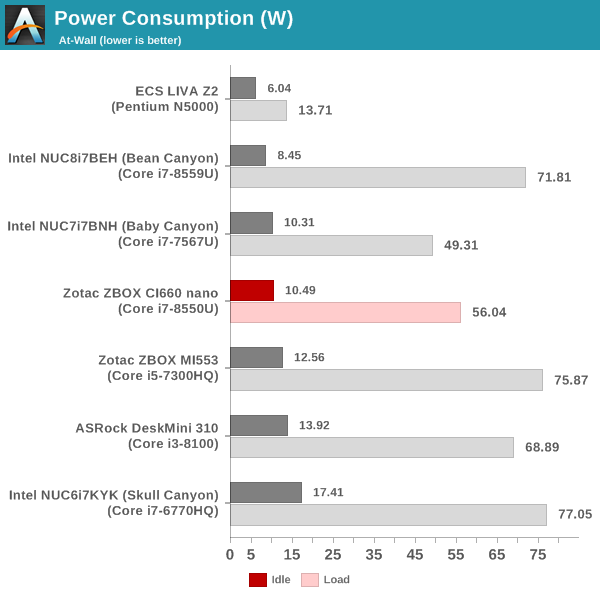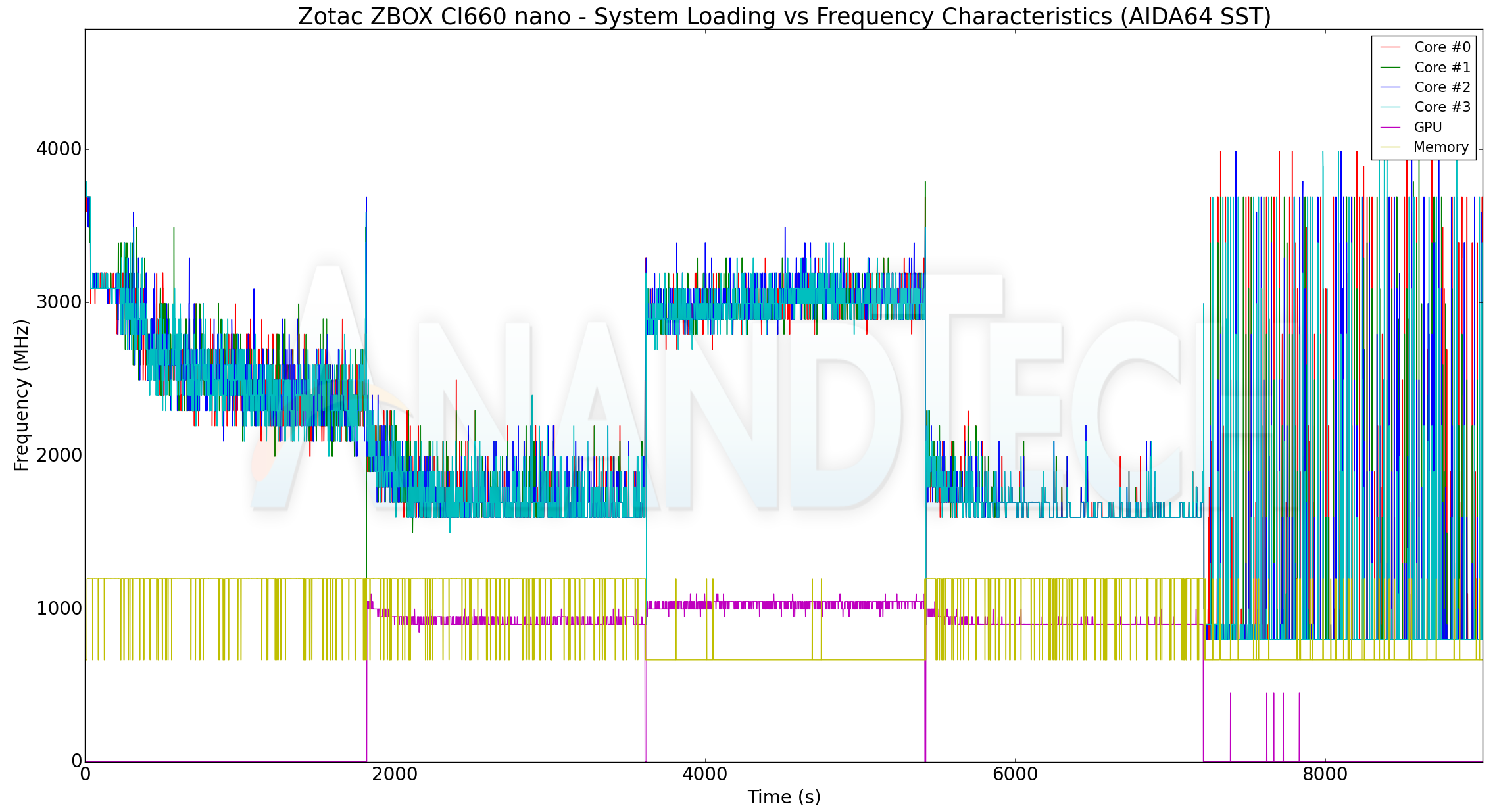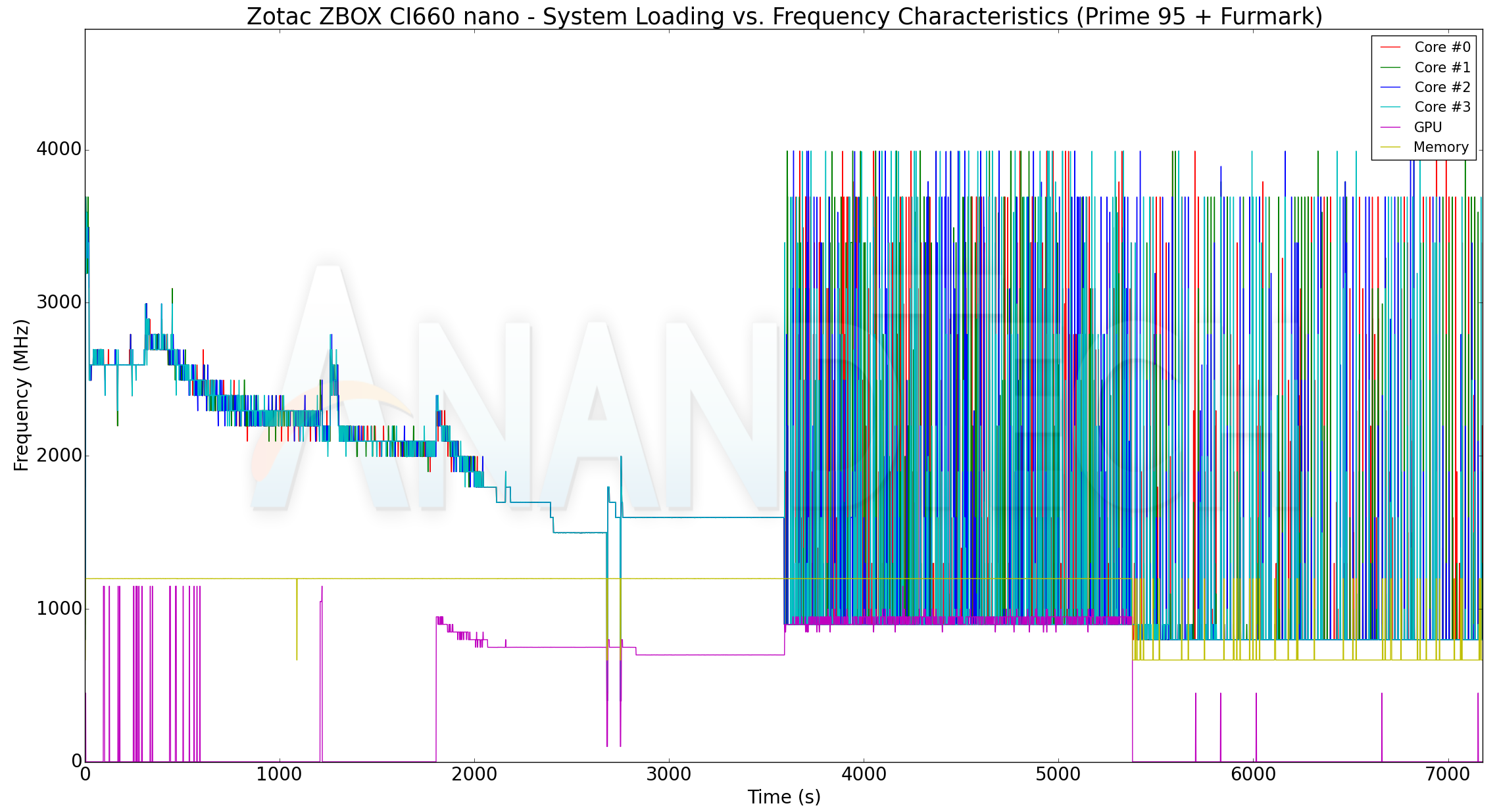The Zotac ZBOX CI660 nano Fanless mini-PC Review: A Promising HTPC Platform
by Ganesh T S on April 16, 2019 8:15 AM ESTMiscellaneous Aspects
The power consumption at the wall was measured with a 4K display being driven through the HDMI port. In the graphs below, we compare the idle and load power of the Zotac ZBOX CI660 nano with other low power PCs evaluated before. For load power consumption, we ran the AIDA64 System Stability Test with various stress components, and noted the maximum sustained power consumption at the wall.

As we see further down, instantaneous peak power consumption at the wall can go as high as 80W. The above numbers (particularly, the idle power consumption) are a tad high, given the fanless nature of the system. Other than that observation, the numbers go hand-in-hand with the system's capabilities.
Our thermal stress routine starts with the system at idle, followed by four stages of different system loading profiles using the AIDA64 System Stability Test (each of 30 minutes duration). In the first stage, we stress the CPU, caches and RAM. In the second stage, we add the GPU to the above list. In the third stage, we stress the GPU standalone. In the final stage, we stress all the system components (including the disks). Beyond this, we leave the unit idle in order to determine how quickly the various temperatures in the system can come back to normal idling range. The various clocks, temperatures and power consumption numbers for the system during the above routine are presented in the graphs below.
| Zotac ZBOX CI660 nano System Loading with the AIDA64 System Stability Test | |||

The Core i7-8550U has a base frequency of 1.8GHz, and can turbo up to 4 GHz. In the AIDA stress tests, we can see that processor maintains a minimum 1.8 GHz clock under all loading conditions. However, the same can't be said for our custom stress test which starts with Prime 95 for 30 minutes, followed by both Prime 95 and Furmark for 30 minutes, and ending with Furmark alone for another 30 minutes. Towards the middle of the second workload, we see the cores drop down to around 1.5 GHz in the graph below.
| Zotac ZBOX CI660 nano System Loading with Prime95 and Furmark | |||

The temperatures are the second item of interest. According to official specifications, the junction temperature of the Core i7-8550U is 100C. However, Zotac seems to have taken the safer route of throttling the performance as soon as the cores hit 85C. What does this throttling entail? The power graphs for the two cases above provide the answer.
The ZBOX CI660 nano initially sets out with the CPU package power allowed to go up to 25W. As soon as the temperature limit (85C) is hit, the permitted package power starts to track down. We find that the thermal solution is good enough to allow the package to operate at 15W while maintaining the package temperature at 85C.










23 Comments
View All Comments
eastcoast_pete - Tuesday, April 16, 2019 - link
Thanks Ganesh! Two comments, one question - question first:Was your choice of a SATA SSD based on the ability of the ZBOX to support (not support) an NVMe SSD, or based on what parts were available?
As a comment, use of slower vs. faster storage (SATA vs NVMe) will obviously affect a number of performance benchmarks. Why not standardize on one unless the unit tested won't support the better option?
My other comment is about the pricing of the ZBOX (bare bone): not a good value proposition for HTPC use, given that the current i7 NUC is cheaper, with a superior CPU/GPU. The presence of two gigabit ethernet connections in the ZBOX might be a plus in certain situations, but otherwise it's overpriced compared to the NUC.
ganeshts - Wednesday, April 17, 2019 - link
No NVMe SSD support in the CI660 nano. I had to use a SATA drive, and chose the best one available at my disposal from a cost viewpoint (at the time I configured the review sample - sometime in early Q4 2018).You are right about standardizing the storage drive. However, we tend to choose a drive available in retail for a reasonable cost at the time of configuring the review sample. Since we review a system or two each quarter, it becomes difficult to use the same drive across a large number of reviews. That said, you can find that we either use Crucial SATA SSDs (MX200 / BX300) or Samsung / WD NVMe SSDs (950 PRO / WD Black / SanDisk Extreme Pro) unless the sample comes pre-configured with different SSDs by the vendor (eg. - Hades Canyon).
The CI6xx nano platform is suitable for HTPCs, though, the i7 model might be a bit too pricey for that sole purpose. As one of the other commentators noted, Zotac does have i3- and i5- models in the series.
mooninite - Tuesday, April 16, 2019 - link
$865 is $300 too much. Looks like most of this cost is tied up with the use of an i7, which is completely unnecessary in this form factor. CPU power is not the limitation here. The GPU is.I can't see this as a big seller over a NUC.
mooninite - Tuesday, April 16, 2019 - link
Also, I wish Zotac had come out with their AMD mini-pcs with Vega graphics. Such a shame... that would have sold. I wonder why they backed out.Haawser - Wednesday, April 17, 2019 - link
Agreed, I'd rather have a 15W Ryzen 7 3700U in this form factor. Because UHD620 is going to be a severe limitation for anything beyond the most basic low res, minimum settings gaming. Whereas at 720p/med fullscreen, Vega 10 should play pretty much anything.No idea why Zotac don't offer a Ryzen APU version. Intel 'discounts' maybe ? Or rather, threats of removing them if Zotac don't play ball ? Wouldn't put it past them to offer 'inducemets' like that. Their history being what it is.
lukethedrifter - Tuesday, April 16, 2019 - link
There are i3 and i5 versions as well, ci620 and ci640 respectively.This is a niche product for those who want something NUC-sized but fanless, for which there are relatively few options.That's the selling point, not that it's price competitive with regular NUCs.
Beaver M. - Monday, April 29, 2019 - link
Or an Nvidia Shield, which is still the best and cheapest way to get what an HTPC is supposed to do.mikato - Tuesday, April 16, 2019 - link
Noise question here... Ganesh, you said you were disappointed in the fan noise of the Intel NUC8i7BEH though I didn't see much detail. How bad was it (idle and when streaming something), and is this ZBOX far better noise-wise because it's fanless?ganeshts - Wednesday, April 17, 2019 - link
The Bean Canyon NUC's fan is problematic because it is small and high-pitched when there is sudden load on the CPU. At idle, not that much. But, network streaming and even Kodi playback sometimes makes the unit hot enough for the fan to turn on. It is audible from 10 ft away, particularly during quiet scenes in the movie. The ZBOX noise is inaudible at that range - so, for the HTPC user who isn't very picky, it might work.That said, there are some passive chasses for the Bean Canyon NUCs in the market. Those might be worth a look. However, that is not a 'ready-out-of-the-box' solution.
mikato - Friday, May 3, 2019 - link
Thanks! Please keep include noise as a concern in these mini PCs.